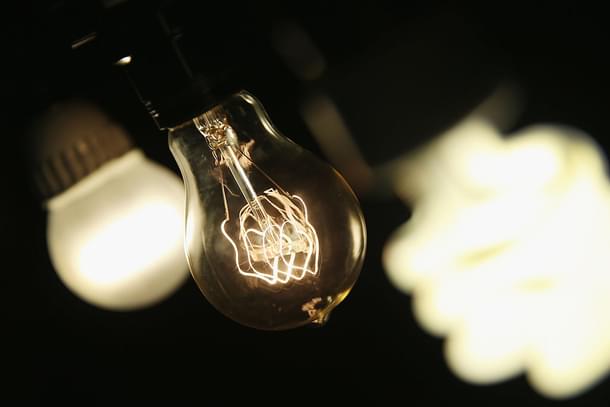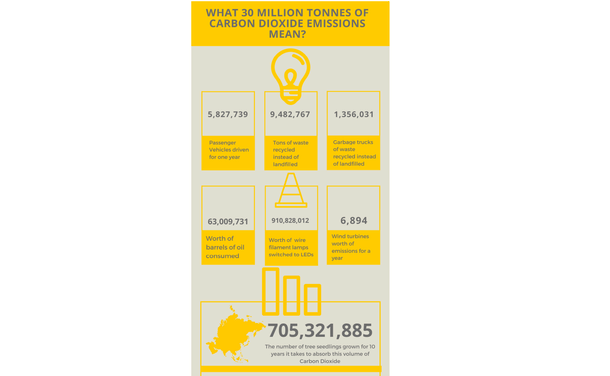Infrastructure
How UJALA Is Making Our Environment Better, One Bulb At A Time
Tushar Gupta
May 17, 2018, 04:59 PM | Updated 04:59 PM IST
Save & read from anywhere!
Bookmark stories for easy access on any device or the Swarajya app.


For India that for long struggled with electricity generation, moving to clean energy options at a nationwide level required, first, an unprecedented approach, and second, leadership. While the first came in the form of ‘Unnat Jyoti By Affordable LEDs for All’ or the UJALA project, the second was demonstrated by Prime Minister Narendra Modi’s simple act of changing one light bulb for LED (light-emitting diode) at the Prime Minister's Office in Delhi’s South Block, heralding a movement for clean energy in the country.
UJALA programme, spearheaded by Railways Minister Piyush Goyal in its initial days, has been one of the most transparent, consistent, and collaborative initiatives of the Bharatiya Janata Party (BJP) led National Democratic Alliance (NDA) government. It’s transparent as people can track its progress through websites and mobile apps. Consistent, as it did not lose momentum after a few weeks like some other programmes of the government. Collaborative, for like Aadhaar, it included a number of kiosks or centres for the subsidised sale of LED bulbs, fans, and tubelights, and inevitably required the support of the people.
Initially known as DELP (Domestic Efficient Lighting Programme), UJALA aims to create awareness among consumers about the use of LEDs for domestic purposes. Any household with a metered electricity connection became eligible to get LED bulbs at a subsidised price from government-enabled centres in their area. Keeping in mind the lower income groups and economically weaker sections, the programme allowed consumers to purchase these LEDs through easy monthly installments attached to their electricity bill. The accessibility factor was catered to brilliantly, for it was indispensable to the success of UJALA.
Under the UJALA programme, 9W LED bulbs, 20W tube lights, and BEE five star rated fans have been uniformly priced at Rs 70, Rs 220, and Rs 1,200 across India, as told by the Energy Efficiency Service Ltd (EESL), the nodal agency for implementing the UJALA programme via power distribution companies and other retail portals, both offline and online.

When exploring UJALA and usage of LEDs, five major components must be taken into account. One, the number of LED bulbs, tube lights, and fans distributed. Two, the energy conserved per year through the use of LEDs. Three, the cost saving per year. Four, the peak demand that was avoided as a result of the LED usage. Five, and the most important, the carbon dioxide reduction that the use of LEDs led to.
In this given data story, we have used the megawatt hour (MWh) (or thousand kilowatts hour) unit to highlight the energy saved and the megawatt unit for the peak demand avoided across different states in India. To put things in perspective, India’s per capita electricity consumption is close to 1 MWh (as reported in 2015). In China, the per capita consumption is 4 MWh while in developed nations it hovers around 15 MWh. Though the 1 MWh (the 2015 report from Livemint put it at 1010 KWh) figure may be optimistic, the prevailing inequality in India signifies in the variability in electricity distribution. With over 300 million people living without electricity in 2014, the government had before it the arduous task of helping every village acquire quality electricity supply.

Choosing LED lighting over conventional options is encouraged as the former produces more light while consuming less electricity. Alongside, it is ideally suited for designer installations, prompting urban people to move to LEDs. Enhanced designs and efficient engineering have made LEDs immune to high temperatures, thus negating the chances of a LED meltdown, an issue early users of LEDs across the world were quick to report.
So, how has the usage of LED bulbs (we are not including tubelights and fans here) across states helped the environment?
Jammu and Kashmir, Himachal Pradesh and West Bengal reduced their carbon dioxide emissions in excess of 8,00,000 tonnes each. Using the greenhouse gas equivalencies calculator from the United States Environmental Agency, we learn that 8,00,000 tonnes (or 7,25,748 metric tonnes) of carbon dioxide is equivalent to 155,406 passenger vehicles driven each year, or 252,874 tonnes of recycled waste, or 36,161 trucks full of garbage waste, or 9,608 tanker trucks’ worth of fuel, or the energy consumption of 78,366 homes for a year. In 8,00,000 tonnes of carbon dioxide, close to 4000 rail cars’ worth of coal can be burned. It would take over 850,000 acres of forest to absorb the same amount of carbon dioxide in a year.
Tripura, Mizoram, Puducherry and Goa have reduced their emissions in excess of 50,000 tonnes (or 45,359 metric tonnes). This volume of emissions are registered by a passenger vehicle after it has been driven for over 111,000,000 miles. Coal burned from 250 rail cars would amount to 50,000 tonnes of carbon dioxide in the atmosphere. However, it would take more than 1,175,000 tree seedlings, preserved for over 10 years, to absorb the same amount.

Haryana, Delhi, Rajasthan, Bihar, Madhya Pradesh, Kerala and Odisha, with their emissions reduced by more than 13,00,000 tonnes (or 1,179,340 metric tonnes) of carbon dioxide are setting examples for the world to follow. This equals the greenhouse gas emissions from over 250,000 passenger vehicles driven for a year, or 410,920 tonnes of recycled waste, or over 58,000 trucks carrying recycled waste. The same volume could sustain the energy consumption of over 127,000 houses in the US for a year, is the same as 6437 rail cars’ worth of coal burned, or 2,730,422 barrels of oil consumed. Interestingly, 13,00,000 tonnes of carbon dioxide emissions can also result from 300 wind turbines powered for over a year.
In Karnataka, Maharashtra and Uttar Pradesh, carbon emissions have been reduced by over 20,00,000 tonnes (or 1,814,369 metric tonnes). This is as good as the emissions from a passenger vehicle that has been on the road for almost 4,447,000,000 miles or 388,000 such vehicles. At the same time, the emissions are equivalent to what one would get if they burned coal from almost 10,000 rail cars. Surprisingly, the emissions are merely 40 per cent in volume of what is generated by a coal-fired plant in the US, the same vouched for by President Donald Trump.
Gujarat, with its emissions reduced by 41,22,214 tonnes (or 3,739,609 metric tonnes), presents a stellar example for the world to follow. While it would take over 96,000,000 tree seedlings grown for over 10 years to absorb the same amount of carbon dioxide, it would only take close to 950 wind turbines to release the same amount, or 400,000 homes’ energy consumption in one year.
While UJALA’s environmental impact has been undermined in the media circles, its significance in the global context must not be undermined. Under the UJALA programme, close to 30 crore LED bulbs have been sold at subsidised prices, and the emissions of carbon dioxide have been cut by almost 30 million tonnes, merely in the third year of the programme.

Turns out, one bulb at a time can go a long way in ushering ‘ujala’ on the path of environmental conservation.
Tushar is a senior-sub-editor at Swarajya. He tweets at @Tushar15_





